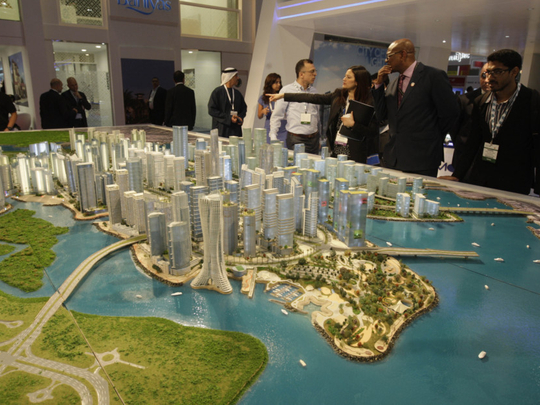
Abu Dhabi’s new project pipeline remains firmly in the hands of its government owned or supported developers, with private sector names keeping to the sidelines or coming out with the occasional foray. And by the looks of it, the situation is likely to remain so.
In the last 12 months, there have been well phased out off-plan launches from Aldar and also by the master-developer in Saadiyat, and which were able to find buyers relatively quickly. But that was about the sum total of off-plan activity in the emirate and at odds with the bullish sentiments developers had shown during Cityscape Abu Dhabi 2014. (The sentiments developers are nursing now could be gleaned from this year’s edition of Cityscape Abu Dhabi, which opens on Tuesday.)
The way oil prices have behaved could explain some of the souring in private developers’ appetite for new.
“It would have been pretty quiet it had not been for the quasi-government entities,” said Matthew Green, regional Head of Research and Consultancy at CBRE. “There’s still good end-user residential demand, but what remains absent is the kind of outside investor driven development activity that had stabilised Dubai’s property market in recent years.”
Private developers’ reticence “could be due to a general lack of information such as transactions and pricing and which does not allow them to arrive at an accurate assessment of potential returns,” said Robin Teh, Country Manager at Chestertons Mena. “Private developers, however, have been active in retail segment where they have developed community malls/centres.”
It could also be that private developers are still content with clearing their ongoing projects rather than risk coming out with new. For instance, Green estimates that Reem Island — already well established as far as its credentials as an upscale residential location goes — will alone add between 35-40 per cent of new capacity over the next three years. But that comes with a rider- all of these are ongoing projects.
“Reem still has lots of potential given the still significant land holdings there,” sad Green. “Outside of the city, there is development happening on small, single plots at Khalifa City or Mohammad Bin Zayed City, but these are not of the massive master-planned variety. But these do not have the ‘investment zone’ status that drives massive master-planned ventures.”
But the Al Maryah master-development ticks all the boxes by offering a sizeable canvas for developers to come in and do their bit. While its retail anchor is still some years off, there is plenty happening to make it as Abu Dhabi’s next destination to be in.
‘Abu Dhabi Global Market Square on Maryah Island is due to commence operations as the city’s dedicated financial free zone shortly’, Cluttons reported in its latest update. When that happens, it would do enough to shift some of the real estate dynamics within Abu Dhabi city’s financial services sector.
‘The new free zone may be an economic game changer for Abu Dhabi and is likely to translate into a degree of economic rebalancing as the finance and banking services sector takes its place among the most important segments of the economy’, the report adds.
Even residential offerings are starting to come through — Farglory Group launched the first tower at its four high-rise ‘Al Maryah Plaza’ project. It is also the first residential project launched on Al Maryah Island, according to CBRE.
But for the city’s resident base, there is not much by way of new capacity being delivered in substantial numbers. Only about 5,000 units are likely to be delivered this year, according to Teh, and which would add to the nearly 200,000 unit stock. “Most projects are in the luxury segment consisting of apartments and remains well supplied,” said Teh.
“As supply is controlled by a limited number of developers, it is quite possible that this could be timed as per demand and market conditions. However, there is a supply gap in the affordable segment category as most freehold areas cater to luxury. There is no separate zoning for the affordable segment, which poses a challenge for a majority of the resident population.”
There could be further pressure imposed even on the existing stock — “A number of demolitions of older properties are taking place in the well-established parts of the city,” said Green. “A number of areas have been marked for redevelopment in the heart of Abu Dhabi and that would certainly have an impact on residential availability in the short to medium term.”
That should be the signal for private developers to get cracking with new launches as all of the factors seem to be in their favour — limited new supply, consistently high demand for whatever is made available, high rentals forcing tenants into buying, etc.
Cityscape Abu Dhabi 2015 can offer some insight into where the market is headed — ‘Residential sales are expected to remain relatively stable in the short term with investors happy to wait during current economic uncertainties before making moves’, the CBRE status report notes.











